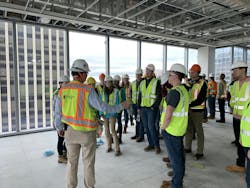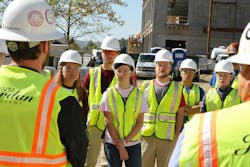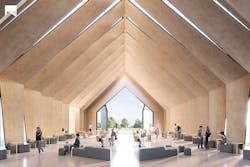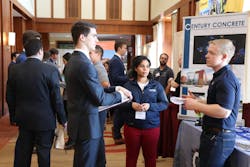College programs help prepare students for careers in the construction industry
For more than a decade, John Klein has been toggling between academia and the construction industry. His new company, Generate, traces its roots to Massachusetts Institute of Technology (MIT), where for more than six years Klein was a teacher and research investigator. Generate exemplifies how universities have been coming down from their ivory towers to nurture ideas that catalyze practical solutions for the built environment.
“It’s an exciting time to be in academia,” says Mani Golparvar-Fard, Associate Professor and Faculty Entrepreneurial Fellow at the University of Illinois at Champaign-Urbana. That’s where he and a colleague, Associate Professor in Computer Science Derek Hoiem, developed the prototype for Reconstruct, a predictive visual data analytics tool used with drones for monitoring construction progress. Golparvar is now Reconstruct’s COO, Hoiem its Chief Science Officer.
VIATechnik, a virtual design and construction firm that provides BIM services, was a startup in 2015 when it was invited to join Stanford University’s Center for Integrated Facility Engineering. “CIFE is a way for us to make sure we always have one foot in the future,” says Danielle Dy Buncio, a Stanford graduate who is VIATechnik’s Founder and CEO. Martin Fischer, CIFE’s Director, is a VIATechnik advisor. “CIFE keeps us nimble,” she says.
Klein, whose résumé includes stints at Zaha Hadid Architects and the faculty at Tsinghua University’s Graduate Architectural Design department in Beijing, says he’s been “fortunate” to always have one leg in practice and another in research.
Brendon Renick Assistant Project Manager with W.M. Jordan, leads students on a tour of a construction site. Courtesy Virginia Tech.
While at MIT, he taught a design workshop whose student architects in 2018 developed a proposal for The Longhouse, a sustainable building prototype using mass timber. The building processes that emerged from the workshop over the past two years are the foundation for Generate, an architectural design consultant focused on providing digitized solutions that incorporate engineered wood products.
In January, Generate submitted for permitting a 19,000-sf, five-story Passive House structure with 14 residential units in Roxbury, Mass. This would be the Boston area’s first ground-up Passive House demonstration project built with cross-laminated timber components. Generate is working in collaboration with Placetailor, a firm dedicated to high-performance buildings.
Sharing knowledge and people
A nexus with industry is common for universities with schools of architecture, engineering, and construction that are striving to be invaluable to AEC firms looking to keep pace with the latest research and trends, especially in the areas of construction technology and management.
“We’re in the knowledge transfer business,” says R. Raymond Issa, PE, F.ASCE, API, Distinguished Professor and School Director of the M.E. Rinker Sr. School of Construction Management and the University of Florida. “Students are the drivers of the latest technology.”
The University of Florida is among the academic institutions that invite AEC firms to co-sponsor classes and send their executives to be guest lecturers, to preside over research proposal reviews, and to conduct jobsite tours for students. AEC firms are also sources of capital to perpetuate a school’s mission.
In January, for example, the architectural firm NBBJ announced that it was donating $250,000 to establish a partnership with the University of Washington’s College of Built Environments, with the goal of translating basic research into action, creating innovative solutions to design problems, and cultivating the next generation of leaders. The multiyear partnership will engage faculty, students, and practitioners in projects, studios, seminars, charrettes, and symposia.
In return for their participations and largesse, AEC firms often have a say in what’s taught and researched. Exhibiting at career fairs—Florida’s School of Construction Management has four fairs annually, each attracting up to 120 companies—gets AEC firms in front of students at a time when the industry is hungry for new talent. And firms get early access to information that could give then a competitive edge.
For the past nine years, Skanska USA’s New York office has had a working relationship with Columbia University’s Civil Engineering and Engineering Mechanics program. One of that program’s lecturers, Dr. Ibrahim Odeh, chairs a think tank under the auspices of the World Economic Forum. In that capacity, Odeh shared research with Skanska five years ago which showed how construction had fallen even below agriculture as the least likely sector to adopt technology. In response to those findings, Skanska redoubled its efforts to bring technology into its work, says Paul Haining, its Chief Environmental, Health, and Safety Officer.
Academia is also where new ideas and products can get road tested. Skanska has worked with Georgia Institute of Technology’s Digital Building Lab (DBL) on a machine-learning 3D model checking tool for construction safety, logistics, and OSHA standards. And before launching its drone program a few years ago, Skanska worked with DBL and Javier Irizarry—an Associate Professor in the School of Building Construction and Director of the school’s CONTech Lab—to study how drones could be deployed for construction. This included testing operational applications for safety, battery and computational power, and regulatory compliance.
“Without the DBL, we would not be where we are today on either of these platforms,” states Oliver Smith, LEED AP BD+C, Associate AIA, Director of Innovation and VDC in Skanska’s Washington, D.C., office. He and other sources point out that an academic environment is sometimes more conducive to such investigations because it is less encumbered by time constraints, narrow agendas, or commercial prerogatives that corporate workplaces must adhere to.
MIT students, in a design workshop conducted by research scientist John Klein, developed a proposal for The Longhouse, a sustainable multifunctional prototype engineered as a series of timber laminated veneer lumber arches spanning across the building’s shorter dimensions. Courtesy Generate.
Universities provide the construction industry with “neutral ground,” where even competitors can share ideas, have open discussions, and collaborate, says Scott Marble, Chairman of Georgia Tech’s School of Architecture in Atlanta. “At Georgia Tech, it’s in our DNA to act as that bridge.” The DBL was founded in 2009 by Professor Chuck Eastman, one of the originators of BIM. Eastman’s successor, Associate Professor Dennis Shelden, cofounded Gehry Technologies. (Shelden is now Director of the Center for Architecture Science and Ecology at Rensselaer Polytechnic Institute.)
DPR Construction has been an associate member of DBL for seven years. As such, it gets invited to evaluate student proposals to determine their funding worthiness. DPR also attends an annual Industrial Symposium that includes tech startups, “so we learn about the latest trends,” says Tony Dong, Leader–Business Process Improvement and Research in DPR’s San Francisco office.
In another layer of support for this program, DPR provides PhD researchers with access to its executives for consultation, as well as data on such things as 3D and 4D modeling. Dong says his firm has a similar membership arrangement with Stanford’s CIFE.
Blurring the lines
The symbiosis of academia and industry is palpable at Virginia Tech, in Blacksburg, Va., whose Myers-Lawson School of Construction was started in 2006 with a $10 million endowment from two construction company CEOs: A. Ross Myers of Allan Myers and John Lawson of W.M. Jordan. “We were formed by the industry, for the industry,” says Brian Kleiner, PhD, Director and Bogle Professor of Industrial & Systems Engineering. “Within the school, we have several communities of practice with attached centers or labs, through which industry, faculty, and students partner.”
Virginia Tech has an industry board comprised of tiers related to involvement, as well as faculty-industry committees. All of its construction students do multiple internships, and the school conducts two career fairs per year. “We are the pipeline to meet the industry’s shortage of construction professionals,” says Kleiner. To widen that pipeline, industry donors pledged $25 million for a building that would double the School of Construction’s physical capacity, in exchange for the university agreeing to double enrollments in its construction management and construction engineering management programs.
When asked how Virginia Tech’s School of Construction meets the industry’s needs, Kleiner points specifically to the school’s new Automation and Robotics in Construction and Design and Engineering (ARCADE) lab. Several companies, including Hourigan Construction, a Richmond, Va.-based GC, are trying to figure out how much and which technology should be adopted for construction. “School researchers are actively addressing the challenge,” says Kleiner.
Ryan Saulsbury, Hourigan’s Executive Vice President, elaborates that this collaboration syncs with the efforts of his firm’s corporate safety director, Brian Rizzo, to elevate Hourigan’s CM practice to “best in class.”
At College Station, Texas A&M’s Department of Construction Science has had a Construction Industry Advisory Council since 1998. That council has grown to 247 member firms, and includes Turner Construction, Lendlease, and Mortenson. The council offers 12 endowed scholarships per year, and a $25,000 research grant, says Patrick Suermann, PE, LEED AP, Associate Professor and the Charles Dewey McMullan Chair in Construction Science. One student team used that grant money recently to build a freestanding 25-foot-tall arch using a robotic arm.
See Also: Meet the ‘AEC outsiders’ who are helping to push the industry into the new decade
The department also has a $20 million research program, much of it funded by federal agencies like the National Science Foundation. That program provided the money for one recent investigation where a student team used wearable sensors to study worker motion patterns on an offshore prefabrication facility. Using that research, tools were relocated to be more convenient for workers to use. Suermann says that heeding this research ultimately saved the facility $1 million in annual operating expenses.
These relationships between academia and industry are two-way streets. Universities rely on industry’s input about what research proposals are worth pursuing. This input typically injects real-world experience into research that, otherwise, might not go beyond the white paper or prototype, says Golparvar-Fard. “And there’s a big difference between the research prototype and practical prototype.” He adds that while the research done at the University of Illinois at Champaign-Urbana is rigorous, “it doesn’t always have relevance.”
Saulsbury of Hourigan Construction says that concepts which universities ask general contractors to test sometimes turn out to be too complex, costly, or would take too long to develop. “This is where firms like ours come in,” to turn ideas into practical solutions, he says.
VIATechnik, which has done more than 2,000 projects, has seen how tech works and who’s using it. “So we can collaborate with research students to solve problems, in ways that don’t need to be commercially viable initially,” says Dy Buncio. VIATechnik also partnered with Stanford to co-deliver CIFE’s first VDC course. “We were able to scale the course and offer real-time industry feedback,” she says.
Where startups can marinate
Universities in recent years have emerged as the go-to places for AEC and ConTech startups to incubate and refine their products and services. ALICE Technologies, the AI platform for construction planning and scheduling, was initially funded by Stanford, for example. Exyn Technologies’ drone navigation software was incubated at the University of Pennsylvania’s Grasp Lab.
However, a product’s development via an academic portal can take all kinds of twists and turns.
Golparvar-Fard contends that startups “bridge the gap” between academic theory and what industry needs. Reconstruct is a case in point.
In an interview last year with Oracle’s Trailblazers blog (bit.ly/3cxuX9m), Golparvar recounted how his research and PhD dissertation at the University of Illinois and at Virginia Tech focused on the interface of construction management and computer vision.
“Reconstruct’s visual 3D command center for construction projects emerged from this work,” he said. Golparvar tells BD+C that he also tapped into UICU’s Entrepreneurial Faculty Fellowship, which provided him with space and a team on campus; as well as the university’s 43,000-sf incubator EnterpriseWorks at Research Park, whose shared services program provided operational and legal support.
His team tested this tool with multiple construction companies, most prominently Turner, which in 2016 greenlighted its use as a pilot program during the construction of the Sacramento Kings’ much ballyhooed Golden 1 Center stadium.
The success of that pilot opened doors for Golparvar to pitch Reconstruct to several other construction firms, including Clark Construction and Gilbane. “The response was overwhelmingly positive,” he recalls. Reconstruct now has offices in Menlo Park, Calif., Chicago, and Austin, Texas. Many of its 35 employees are graduates of the University of Illinois.
Perkins and Will has been working with Georgia Tech’s DBL on an automated planning layout tool, which started when John Haymaker, P&W’s Director of Research, was an assistant professor there. (He also taught at Stanford’s CIFE, where he earned his PhD.)
A student named Subhajit Das had created a Space Plan Generator, that put lists of spaces into a tool to come up with an adjacencies matrix to produce a space plan. Through his class, Haymaker connected Das with P&W and Autodesk. “P&W showed how us they did healthcare space planning, and Subhajit, under my guidance, tested” the generator.
Haymaker says the Space Plan Generator didn’t quite meet the levels of precision and geometric control that users required. “We needed to connect analyses into this generative loop more easily,” he explains. The school and P&W may have found that solution in the work of another student, Nirvik Saha, who has created a Design Optimization Tool Set (DOTS, as in “connecting the dots,” quips Haymaker), a series of Grasshopper components that allows designers to more precisely implement their own design logic using a sequence of scripts. Saha is preparing to defend his thesis.
Sean Quinn, Sustainable Design Director for HOK Group’s Pacific Region, has had a longstanding relationship with Christoph Reinhart, Associate Professor at MIT’s Energy Initiative and Sustainable Design Lab. Last year, Reinhart, who is also CEO of Solemma—which distributes a daylighting and energy modeling RHINO plug-in called DIVA—proposed the formation of an Executive User Group under Solemma to raise capital for the development of a suite of circadian light software tools under the name Climate Studio.
HOK, says Quinn, was the first AEC firm to invest in that user group, which has since grown to 15 investors. The user group includes such AEC firms as Arup, Foster + Partners, AECOM, BuroHappold Engineering, Kieran Timberlake, P&W, atelier 10, Skidmore Owings & Merrill, and Gensler; as well as Harvard, University of California at Berkeley, MIT, and Cornell University.
Quinn says the team that has worked on Climate Studio for a year was scheduled to release it publicly on March 20.
Strengthening the connections
“The pairing of academia and industry can be a powerful mix,” says P&W’s Haymaker. “And part of the research ‘story’ is having practical impact.” The universities interviewed for this article would agree unanimously, as they prepare their students to become leaders in the construction field.
Suermann of Texas A&M says he wants to introduce a program he’s familiar with from his days teaching at the Air Force Academy’s Department of Civil and Environmental Engineering: a Field Engineering and Readiness Laboratory, which provides cadets with a solid foundation for learning scientific theory and engineering design principles in more advanced courses.
The University of Washington’s College of Built Environments is piloting an Applied Research Consortia (ARC), whose purpose is to better align students with industry partners on various projects. Its agenda also promotes equity, diversity, and inclusion to encourage women and minorities to enter and stay in the construction industry. Carrie Sturts Dossick, Professor of Construction Management, envisions that ARC will partner with other colleges within the university to be part of between eight and 10 degree programs. Fees from member businesses would go toward scholarships for students.
Dossick is the former Executive Director of the university’s Center for Education and Research in Construction (CERC), from which ARC is an offshoot. She sees programs like these as the linkage connecting academia and industry. They broaden the faculty’s impact, give students greater exposure to real-world work-related problems, and allow industry to explore new things it might otherwise not do in a commercial context.
“We’re excited about this program’s potential,” she says.



